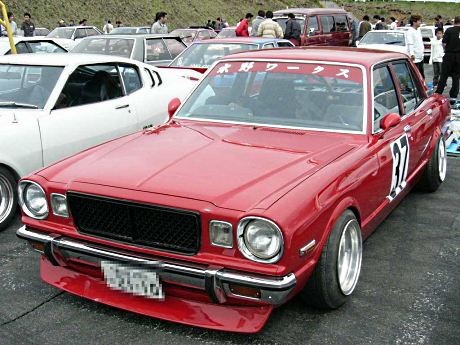Bosozoku Cars are a fascinating and often misunderstood aspect of Japanese automotive culture. The term “bosozoku” itself, translating to “violent running gang,” might conjure images of outlaw bikers, and while the subculture shares roots with motorcycle gangs, bosozoku cars represent a unique and flamboyant form of automotive expression that goes beyond mere gang affiliation.
While it’s true that bosozoku originated with motorcycle gangs in Japan, the aesthetic and philosophy have expanded to car modification, attracting enthusiasts who appreciate the style without necessarily being part of any gang. Referring to them purely as “gang cars” is a simplification that misses the broader appeal and cultural significance of this style.
The term “zokusha” (???) is often used in Japan and is perhaps a more accurate descriptor. “Sha” means car, so “zokusha” literally translates to “gang car.” However, even this term doesn’t fully capture the essence for many enthusiasts who embrace the style for its visual impact and connection to a rebellious automotive spirit.
The bosozoku car style is known by various names, often overlapping and representing slightly different nuances within the broader subculture. These include:
- Shakotan
- Yanky Style
- VIP Style
- Kyusha Style
- Grachan
Shakotan
Shakotan (???) literally means “low car.” This style emphasizes an extremely low ride height, often achieved through drastic lowering modifications. Shakotan cars frequently feature extended front spoilers, rear wings, and prominent exhaust tips. The popularity of this style was significantly boosted by the manga and anime series “Shakotan Boogie,” which featured brothers driving heavily lowered cars, most notably a white Toyota Soarer Z10. Shakotan is often considered a more restrained or “mild” entry point into the broader bosozoku aesthetic.
Yanky Style
Emerging from the Osaka area in the 1970s and 80s, Yanky (or Yankii) style draws inspiration from the colorful fashion trends of the time. “Yankees” in this context referred to individuals sporting vibrant Aloha shirts and pants, often associated with rebellious youth. This fashion sense bled into car culture, and “Yanky style” bosozoku cars often feature bold colors and widened fenders. A notable example is the blue (later yellow) Nissan 240Z S30 from “Shakotan Boogie,” adorned with “Yanky Mate!” in large letters. Yanky style is often seen as closely related to Shakotan, with wider fenders being a key distinguishing, but often subtle, characteristic.
VIP Style
VIP style represents a crossover between Shakotan and the more opulent side of bosozoku. It focuses on luxury vehicles, lowered dramatically and adorned with “bling” – think chrome, polished surfaces, and an abundance of accessories. VIP style cars often sport large diameter wheels and are packed with aftermarket novelties. While VIP style can sometimes resemble bosozoku, a key difference is the age of the vehicles. VIP style typically utilizes newer, luxury models, whereas bosozoku often embraces older cars from the 70s to early 90s, making it arguably a more “low budget” but equally impactful form of expression.
Kyusha Style
Kyusha (???) style translates to “Japanese old classic car.” Kyusha focuses on modifying vintage Japanese vehicles, typically with subtle fender flares, a lowered stance, and stylish period-correct wheels. While Kyusha cars are modified classics, they are generally considered distinct from the more extreme bosozoku style. Kyusha emphasizes a tasteful and respectful enhancement of classic designs rather than the overt flamboyance often associated with bosozoku.
Grachan
Grachan, or Garuchan, derives its name from the Grand Championship races held at Fuji Speedway in the 1970s and 80s. Bosozoku groups would gather in the parking lots of these events, leading to the style’s নামকরণ. Grachan cars emulate the racing aesthetics of the era, particularly the Super Silhouette racing cars, characterized by extremely wide, bolt-on fender flares and aggressive body kits. Grachan is undeniably a core component of the bosozoku style, embodying its wilder and more visually arresting aspects.
Bosozoku Style Defined
Ultimately, bosozoku style, in its purest and most comprehensive form, is a fusion of all the aforementioned styles and more. It’s the unrestrained and audacious culmination of Shakotan’s extreme lowering, Yanky’s wide fender flares, Grachan’s racing-inspired body shapes, and even the exaggerated exhaust pipes reminiscent of bosozoku motorcycles. Bosozoku cars are a visual spectacle, a vibrant and rebellious expression of automotive individuality that continues to fascinate and inspire car enthusiasts worldwide.
